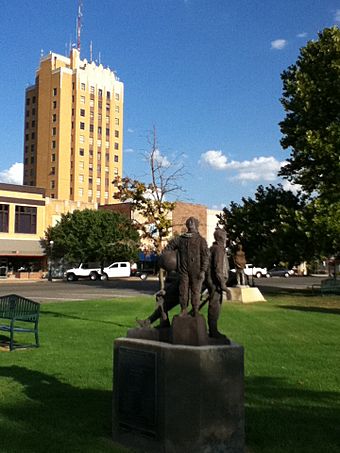Enid Downtown Historic District facts for kids
The Enid Downtown Historic District is a special area in Enid, Oklahoma. It's like a time capsule of old buildings and history! This district is so important that it was added to the National Register of Historic Places in 2007. This means it's officially recognized for its historical value. In 2019, the district grew much bigger, from 7 blocks to 21 blocks. It now includes parts of the original town plan from 1893 and other old neighborhoods.
|
Enid Downtown Historic District
|
|
 |
|
| Lua error in Module:Location_map at line 420: attempt to index field 'wikibase' (a nil value). | |
| Location | Roughly bounded by Maple Ave., Cherokee Ave., Adams St., Enid, Oklahoma and railroad tracks |
|---|---|
| Area | 296 acres (120 ha) |
| Built | 1900 - 1957 |
| Architect | Layton, Hicks & Forsythe; Hawk & Parr, Don Wright, Louis A. Simon, Smith-Day, Davis and Davis |
| Architectural style | Art Deco, Classical Revival, Commercial, Mission/Spanish Colonial Revival, Colonial Revival |
| NRHP reference No. | 07001265 (original) 100004167 (increase) |
Quick facts for kids Significant dates |
|
| Added to NRHP | December 12, 2007 |
| Boundary increase | July 15, 2019 |
Explore Enid's Historic Downtown Buildings
Many amazing and historic buildings are part of this district. They show off different styles of architecture from the past. Here are some of the most famous ones:
- First National Bank of Enid, built in 1922, shows a Classical Revival style.
- Broadway Tower, from 1931, is a great example of Art Deco design.
- Enid Masonic Temple, built in 1924, features an Italian Renaissance Revival look.
- The Woolworth building, from 1921, also has an Art Deco style.
- The Montgomery Ward building, built in 1934, shows a Colonial Revival style.
- The Sears building, from 1927, is in a Commercial Style.
- The Shield building, from 1933, has a Mission/Spanish Colonial Revival design.
- Garfield County Courthouse, built in 1936, is another Art Deco building.
- The United States Post Office and Courthouse, features a Classical Revival style.
- The IOOF building at 223-225 South Grand Avenue, is in a 20th Century Commercial style.
- The Public Library of Enid and Garfield County at 120 West Maine, shows a New Formalism style.
- The Enid Masonic Temple at 126 South Independence, is Classical Revival.
- The Knox building at 303-305 West Broadway, has an Italian Renaissance Revival style.
- The Security National Bank at 201 West Broadway, is in the Modern Movement style.
- The Pioneer Telephone and Telegraph building at 216-218 North Independence, features Italian Renaissance Revival.
- The Billings Theatre at 122 N. Independence, has a Mission/Spanish Colonial Revival design.
You'll also find two important statues in the district:
- The Doughboy statue, from 1924, honors soldiers.
- A Statue of Liberty, set up in 1950 by the Boy Scouts of America, is a smaller version of the famous New York landmark.
The Story of Jonesville
Back in 1893, a young cowhand named Walter M. Cook rode his pony super fast to be the first to claim land in the new town of Enid. He claimed 160 acres just north of the town square.
Soon, many other people followed him. About 300 people settled on the land, calling it "Jonesville." They even planned it out as a separate town! Jonesville was next to Enid's town square. The part of Jonesville that is now in the Historic District is along East and West Randolph streets.
Walter Cook built a house on his land. But many other people also built houses there. Cook had to leave Enid for a while to deal with legal issues about his land claim. When he came back, his house was gone, and others had taken over his land. Because he left, the government decided he had given up his claim. The people of Jonesville won the land dispute.
In 1895, the citizens of Jonesville asked to become part of Enid. Enid agreed, and Jonesville officially joined the city.
Walter Cook later became a "Rough Rider" in Cuba, which was a group of soldiers led by Theodore Roosevelt. He also toured with a wild west show, got married, and opened a steakhouse. He passed away in 1936.
Images for kids














